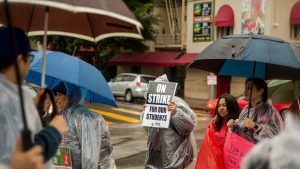Kim Kelly in Teen Vogue:
 The word strike seems to be on everyone’s lips these days. Workers across the world have been striking to protest poor working conditions, to speak out against sexual harassment, and to jumpstart stalled union negotiations. And as we just saw with the Los Angeles teachers’ successful large-scale strike, which spanned six school days, strikers have been winning. Despite the shot of energy that organized strikes have injected into the labor movement, many people aren’t content with run-of-the-mill work stoppages, or even with more militant wildcat strikes.
The word strike seems to be on everyone’s lips these days. Workers across the world have been striking to protest poor working conditions, to speak out against sexual harassment, and to jumpstart stalled union negotiations. And as we just saw with the Los Angeles teachers’ successful large-scale strike, which spanned six school days, strikers have been winning. Despite the shot of energy that organized strikes have injected into the labor movement, many people aren’t content with run-of-the-mill work stoppages, or even with more militant wildcat strikes.
As President Donald Trump’s scandal-plagued government shutdown stretches into its fourth week and more than 800,000 federal workers struggle to survive sans paychecks, the words general strike have begun appearing with increasing frequency on social media and in a spate of articles. On January 20, Association of Flight Attendants-CWA President Sara Nelson suggested that a general strike could potentially end the government shutdown. The fact that a labor union official is speaking about such drastic action now is very significant, for one thing because there has not been a major U.S. general strike since the government cracked down on labor following 1946’s Oakland general strike. Also, a general strike is an incredibly massive undertaking; while many organized industry-specific strikes can comprise hundreds or even thousands of workers, a general strike could potentially involve millions.
So what does it all mean? How is a general strike different from a planned, industry-specific work stoppage; why are people interested in the idea now; and what would one look like in 2019?
More here.
